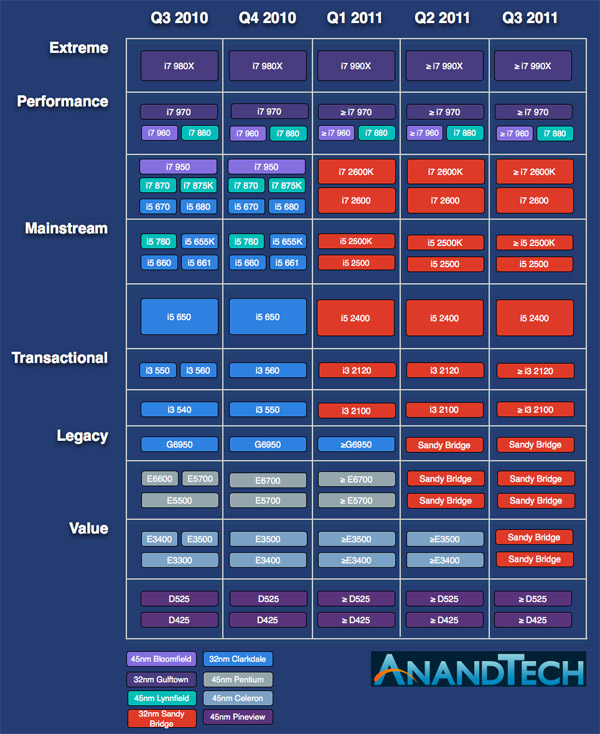The Sandy Bridge Preview
by Anand Lal Shimpi on August 27, 2010 2:38 PM ESTThe Roadmap & Pricing
I’ve defined the launch parts earlier in this article, but now I’m going to put them in perspective. When Intel provides its partners with roadmaps it also provides them with an idea of where future CPUs slot into various segments/price points. For example, Intel’s LGA-1366 roadmap tell us that in the “Extreme” market segment Intel only has a single product offering: the Core i7 980X. And in Q1 2011 the 980X gets replaced by the 990X.
Usually based on this information you can get a general idea of how much future products will cost - or at least what they will be comparable to. In this example the 990X will most likely be priced at whatever the 980X is priced at. Products may change, but the price people are willing to pay in a certain market segment usually doesn’t.
What we have below is the Intel roadmap, with Sandy Bridge included, for Q3 2010 through Q3 2011. The further out you go in a roadmap the lower your accuracy becomes, so I wouldn’t worry too much about us not seeing LGA-2011 on there yet.
It’s based on this roadmap that I mentioned some pricing earlier. If all stays the same, the Core i7 2600K will take the place of the Core i7 950, currently priced at $562. The 2600 will fit somewhere around the 680 and 875K ($342) and the 2500K will replace the i5 760/655K ($205 - $216).
The cheapest Sandy Bridge at launch will be the Core i3 2100, which will replace the i3 560 at around $138.
Now pricing is always a huge variable, but I have to say, based on the performance you’re about to see - these parts would be priced right.











200 Comments
View All Comments
Mithan - Tuesday, August 31, 2010 - link
I will be buying one of these the day it comes out.The only question will be between whether I get a CoreI5 or the Corei7. It will depend on price I guess, as the max I am willing to spend on a i7 CPU is $250.
Anyways, should be a nice upgrade to my E8400.
starfalcon - Tuesday, August 31, 2010 - link
Considering how great of a quad core the Core i5-750 is at $195, hopefully they'll have some great quad cores at about $200.Sabresiberian - Tuesday, August 31, 2010 - link
I've often wondered why people don't use WoW to test their video performance in the computers they are testing, and the obvious occurred to me - it so much depends on where you are and what the population is in the area you are in, that the frame rates vary widely. I imagine the frame rates reported here were for an area like Durotar with no one else in sight, heh. It would be a good place in terms of consistency, anyway, though less taxing that somewhere in Storm Peaks.WoW is often described as a CPU-intensive game, and so a great game to be included in tests of CPUs like you are doing here. Thanks for including it! I hope it is used for more video card tests as well; WoW may not be the most taxing test bed at lower end video, but at upper end in some areas it can hit 4 GHz i7 based Crossfired systems hard. I like playing at 85 Hz everywhere in the WoW universe I go - and Cataclysm will bring new video challenges, I'm sure.
drunkenrobot - Tuesday, August 31, 2010 - link
I'm a bit disappointed at Intel's attempt to completely lock us out of over clocking all together. But maybe this is AMD's chance to win back the enthusiast market. If AMD sold only unlocked parts, they would have a market segment all to themselves...theangryintern - Wednesday, September 1, 2010 - link
OK, didn't see it in the article and don't really feel like wading through 200 comments. What I want to know is will we be able to either A) disable the onboard graphics if we have the latest and greatest bad-ass video card...or even better, B) Will it be able to run both at the same time in a configuration where when I'm doing just generic web surfing, emailing, etc, the Intel GPU is doing the work and the discrete card can power down (quieter and less heat generated), and then when I fire up a game, the discrete powers up and the onboard powers down?JonnyDough - Thursday, September 2, 2010 - link
Intel is screwing over minorities! Colorblind people unite!"Both H67 and P67 support 6Gbps SATA, however only on two ports. The remaining 4 SATA ports are 3Gbps. Motherboard manufacturers will color the 6Gbps ports differently to differentiate."
JonnyDough - Thursday, September 2, 2010 - link
Higher performance integrated GPU's should help bring some of the gaming market back to the PC. That is a very good thing. :)starx5 - Tuesday, September 7, 2010 - link
I'm sorry anand but is this because your intel frendly?Come on..you have to run high resolution(2560x1600 or higher eyefinity) gaming benchmark too.
Sandbridge is nothing if it doesnt have much supiror performance in high resolution gamming.
But I know intel sucks. Even 980X is sometimes sucks in high resolution gaming.
When I see your bench, I can clearly SEE your intel frendly. Espesilly in gaming part.
Anand, of course your site is very popular(even in my country korea).
But in reality..your nothing but a intel suckass indian.
wut - Friday, September 10, 2010 - link
Stop. You're making yourself look like a bigoted fool.mekdonel - Friday, November 5, 2010 - link
Naaah, you're not a Korean. Only Americans make dumb spelling mistakes like "your" in place of "you're".